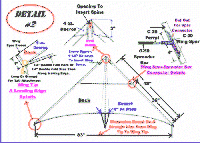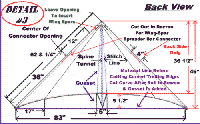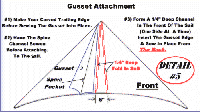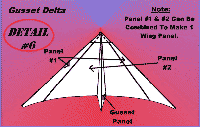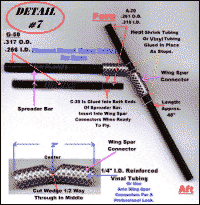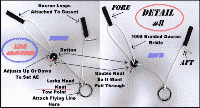This is a fun kite to build & fly, it's moderatly difficult to make, but can be accomplished even by the novice kite builder. Care needs to be attended to in the construction, as with all multi panel Delta kites, to prevent improper balance.
4 sq. yards of 3/4 oz. ripstop material. (Color scheme may require more.)
4 oz. Dacron for reinforcements & wing spar sleeves.
6 inches of 1/4" I.D. reinforced vinyl tubing.
8-vinyl end caps.
4-A-20 (.261 O.D.-.219 I.D.) Filament wound epoxy spars for wing spars.
2-G-50 (.317 O.D.-.266 I.D.) Filament wound epoxy spars for spine & spreader bar.
1-9/16" split key ring for tow point.
100 lb. test braided Dacron line for bridle & flying line.
Since the Gusset Delta is constructed from seperate panels, it requires careful piecing in order to fly true. I will add a short section on tips for this kite, plus a couple ideas on how to balance the flying characteristics if your kite turns out to be a "
leaner".
Make sure all sections are laying flat on your work surface when you are measuring & positioning. Also be sure the pieces to be sewn are laying flat.
1) Select your color scheme, &
make allowances for all hot-cuts & sail seams applied throughout, except for the wing spar sleeves. Usually 1/4" extra on the seam edges is adiquate for your sail seams.
2) Make permanent templates from "Hard Board" which can be purchased from a local art supply store.
Cut your panels out according to the measurments on the back view graphic.
Detail-3
Hard Board is reusable & waxing the edges will prevent burning them & help keep the template from sticking to the material.
Keep in mind, that Panel #1 is a full size template, which when seperated will yield your two leading edge wing panels, while Panel #2 & the Gusset Panel template needs to be made in a
half template as shown in the graphic below.
Detail-4
3) Using a hot cutter, cut out each panel & carefuly seperate without tearing the material where melted together.
4) Sew panels #1 (Left & Right sides) to panel #2 using the stitch of your choice. ( We generally use a straight stitch for sail seams & zigzag stitch for appliques & wing-spar sleeves.)
Be sure to sew them in a manner as to have a front & back for appearance purposes.
5) If you decide you want a curved trailing edge, now is the time to do this.
Remember to leave an additional 1/2" for the double fold hem on the trailing edge unless you plan to use double fold bias tape, which we recomend.
Do NOT finish off the trailing edge until your kite has been flown to determine if it flys straight.
6) Use a 12 1/2" radius to make the arc on the aft end of the Gusset Panel before sewing it to the sail.
A) The radius will extend about 3" onto panel #2, the remainder of the trailing edge is a straight cut, though it can be given a curve if desired.
B) Remember to give hem allowance on the Gusset aft end before cutting it out if you are not using bias tape. This can be finished off with the double fold hem, or bias tape now.
7) Fold your Gusset precisly in half & form the spine sleeve as shown in
Detail-1 & stitch along the complete length of the Gusset Panel 1/2 in. from the fold. This will make the tunnel for the spine, which will be made from a G-50 spar.
A) Sew off the aft end of the spine tunnel on the Gusset.
(Not the fore end!)
8) Next sew the Gusset wedge to the sail.
Gusset Attachment Details-5
This will be accomplished by making a fold in the proper location on the sail & "sandwich" it into the
front side of the sail. Remember, this will be at an angle because this is a "Wedge". Make sure you have marked this line on the Sail before sewing as seen on the Gusset Attachment Details Graphic.
Detail-5
Your sail is now baisicly completed. Wing panels are sewen together & the Gusset is attached.
9) Fold back the "nose" about 3" & allow a gap to insert the spine in the Gusset channel you have already made.
Do not sew the nose Dacron in place yet. See details for the nose.
Details-2
A) Sew the 4 oz. Dacron in place on each leading edge of the wings & add an additional piece to the tips of each lower wing tip. Trim any overlaped pieces by hot cutting it while being careful not to cut the sail or the Dacron wing-spar pocket.
See Detail-2
B) Make the "tow" line attachments by folding a 1 1/2" X 3" strip of Dacron over itself twice for a 1/2" X 3" strip. This will make two pieces. Sew these in place as show.Then stitch them onto the bridle connect points as shown on the main layout graphic.
Details-1
C) Sew the 4 oz. Dacron inplace on the nose, being sure to leave an opening for the spine & wing-spars to be inserted.
10) Make your wing-spar attachments. The plan I show for the wing & spreader bar construction can be used on any Delta type kite including Stunt kites.
I prefer to use
Avia molded wing spar connectors to give a more professional appearance. If molded connectors aren't avaliable for the size of spar I am using (like FL 370, 414 & 505) then I use
only the
reinforced vinyl tubing.
Wing-Spar Connector Detail-7
11) Cut the wing spars to the proper length. You will need to "ferrel" these to make the proper length. Glue only one end of the "ferrel" into the long section (probably this will be the lower piece.) This will make it easy to break down if you want, & to put the wing-spar connecton on. Add end caps to each end.
A) Insert into wing-spar sleeves & attach the wing-spar connector.
B) Cut the spreader bar to length, cut pieces of C-20 for "ferreling" & glue into plase in each end of the spreader bar leaving approxamently 1" sticking out to insert into the wing-spar connector.Remember to have your spreader bar long enough to keep the sail very tight.
12) Cut the spine to length & add end caps to each end. Insert into Gusset channel.
13) Make your bridle according to the specified lengths & attach by using overhand-loop knots.
Detail-1
Tips
1) The reason
not to finish off the trailing edge before flying, is that multipal panel Deltas tend to be "
leaners".
A) To correct this problem note which direction the kite is leaning to.
If it leans to the left, trim a very
small amount off this side on the trailing edge by hot cutting it again. If it leans to the right, trim this side.
This is another reason to make permanent "Hard Board" templates.
B) Make an extra heavy tail for the opposite side from which the kite is leaning.
C) Make a counter balance out of the spreader bar. Cut a small piece of metal tubing that will fit over the spreader bar & keep it in place with two pieces of surgical tubing. (which will grab onto the spreader bar) This will be placed on the opposite side from which the kite is leaning.
Simply adjust it in or out until the kite is flying true.
D) Once your kite is flying true, finish off the trailing edge by hemming it, or applying 1/4" bias tape.
This is the method I reccomend insted of the heavier tail or the counter balance method.
2) Make a "Line Adjuster" using a 4 hole button as shown in
Detail-8.
This will make it possiable to adjust your AE (Angle Of Elevation) for different wind conditions. This particular kite has an AE of + or - 66 degrees.
Remember ..... Always share your nifty new kite with your wife, husband, friend & never forget to share it with those wonderful little kids that stand on the sideline with sad little eyes & longing looks because they have no nifty, new Gusset Delta kite like you do :-)





